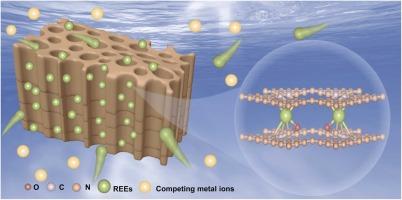Microenvironment Modulation of Two-dimensional Defective Carbon Nitride with Extended Nanoporous Furnished Oxygen-enriched Sites for Efficient Recovery of Rare Earth Elements
IF 12.2
1区 环境科学与生态学
Q1 ENGINEERING, ENVIRONMENTAL
引用次数: 0
Abstract
Efficient recovery of rare earth elements (REEs) from wastewater is crucial for environment remediation and the sustainable development of resources. Nevertheless, achieving efficient and selective REEs extraction in the systems containing low concentrations REEs and high concentrations competing metal ions remains a challenge. Here, we report on the fabrication of two-dimensional defective carbon nitride (DGCN-K) with extended nanoporous furnished oxygen-enriched sites, which is achieved through re-arrangement of framework structural unit using a flexible polycondensation-ion-thermal strategy. The extended nanoporous and continuous transmission nanochannels establish a dedicated structure microenvironment surrounding the active sites center, promoting the effective ion diffusion and increasing the accessibility of active sites. Meanwhile, the incorporation of abundant electronegative cyano and hydroxyl group modifies coordination microenvironment, improving hydrophilicity and strengthening interaction affinity with REEs. Consequently, DGCN-K shows excellent REEs adsorption performance, achieving high adsorption capacity (Nd(III) 146.25 mg/g, Dy(III) 180.82 mg/g, Lu(III) 204.34 mg/g,) within short adsorption equilibrium time (30 min). Furthermore, DGCN-K possesses high REEs selective removal rate in the mixed binary system and actual leaching tailings. This study provides a feasible microenvironment regulation strategy for the construction of 2D defective carbon nitride with oxygen-enriched sites and extended nanoporous for synergistically enables efficient recovery of REEs.

求助全文
约1分钟内获得全文
求助全文
来源期刊

Journal of Hazardous Materials
工程技术-工程:环境
CiteScore
25.40
自引率
5.90%
发文量
3059
审稿时长
58 days
期刊介绍:
The Journal of Hazardous Materials serves as a global platform for promoting cutting-edge research in the field of Environmental Science and Engineering. Our publication features a wide range of articles, including full-length research papers, review articles, and perspectives, with the aim of enhancing our understanding of the dangers and risks associated with various materials concerning public health and the environment. It is important to note that the term "environmental contaminants" refers specifically to substances that pose hazardous effects through contamination, while excluding those that do not have such impacts on the environment or human health. Moreover, we emphasize the distinction between wastes and hazardous materials in order to provide further clarity on the scope of the journal. We have a keen interest in exploring specific compounds and microbial agents that have adverse effects on the environment.
 求助内容:
求助内容: 应助结果提醒方式:
应助结果提醒方式:


